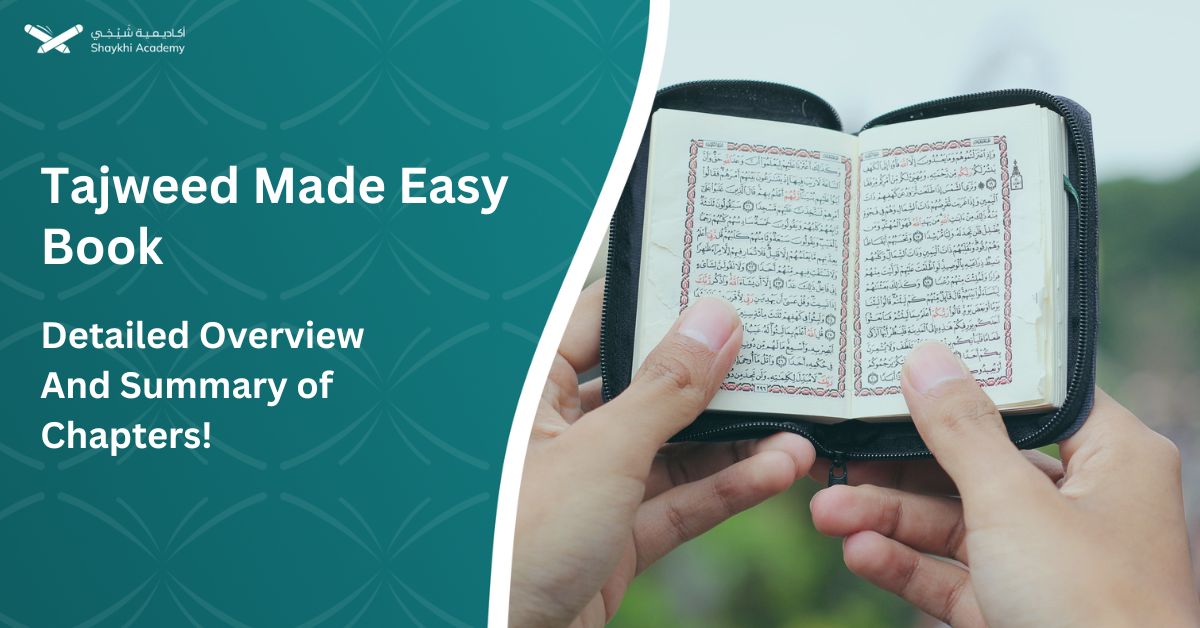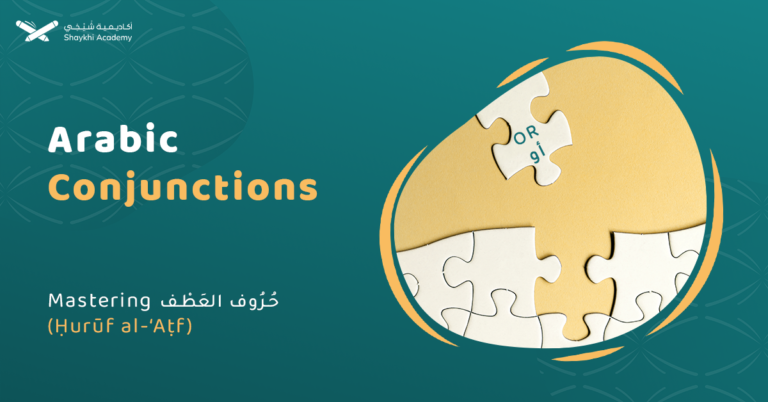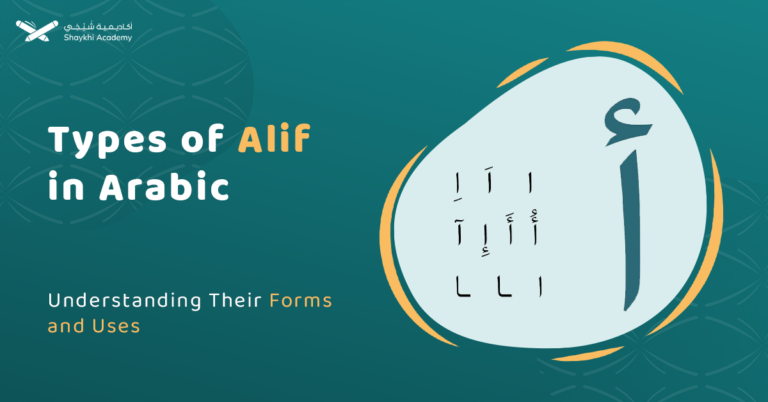Tajweed Made Easy written by Abu Saad Omar Farouq is one of the famous Tajweed books targeting beginners and Quran tutors in the Quranic learning journey. In this article, we briefly cover the most important information addressed in the book and evaluate the book from different aspects so that the reader can form a balanced perspective helping them improve their Quranic learning experience.
Tajweed Made Easy: Book Introduction
To begin with, the introduction of the book provides a guide to help readers understand the significance of learning Tajweed precisely. It also illustrates methods and techniques that assist both tutors and students in maximizing their benefits. Additionally, the author offers a guide for marking and fixing mistakes, ensuring a fruitful experience by avoiding repetitive errors.
Lessons 1-2: Makharij & Letters In Groups
The book begins with the points of articulation (makharij), emphasizing the importance of students knowing the Arabic letters. Instead of learning the makharij of Arabic letters in alphabetical order, the author suggests the following teaching sequence:
- Step one: Start with the “fat letters,” which are pronounced by elevating the back part of the tongue. These seven letters are: خ ص ض غ ط ق ظ.
- Step two: Move to the “throat letters,” which include the following six letters: ء هـ ع ح غ خ.
- Step three: Introduce all Arabic letters. Here, the author arranges the letters in alphabetical order and provides visual aids for each letter, with the other letters sharing the common makhraj indicated in the margin.
In the second lesson, the book groups Arabic letters according to their makharij. Afterward, the author identifies letters with similar sounds and advises teachers to use the talqeen method—where the teacher listens and the student repeats—to develop proper pronunciation and fluency in reading. Overall, this section is one of the simplest and best-covered parts of the book.
Lessons 3-6: Single Letters, Short Form, Combined Letters & Short Vowels
In this section, the author presents the Arabic letters in their single form as well as all possible shapes when connected to other letters. Then, he presents the letter sounds “short vowels” separately. In my opinion, this section is confusing within the book’s sequence. It would have been better to merge it all and present letter sounds together with their shapes.
To illustrate, it is usually not preferable to introduce the Arabic letters by name at the beginning of the Tajweed journey. Rather, it is more effective for the teacher to start with the sounds of short vowels, using these as the basis for teaching the various shapes of letters. This approach facilitates smoother reading. In language teaching, prioritizing sounds over letter names is commonly used, and this is effective not only for teaching Quranic reading but for teaching languages in general. Also, the author delays long vowels for lesson 10 although it is connected to short vowels.
Lessons 7-9: Tanween, Sukoon & Qalqalah
Next, the author explains the different cases of tanween in tajweed with Quranic examples, followed by a lesson on sukoon. However, it would have been more suitable to teach sukoon first as a foundation for understanding tanween. Additionally, it would have been beneficial to explain the rules of noon sakinah—at least in their simple form based on the tanween shape—immediately after the tanween explanation. Instead, the author delays the noon sakinah rules to lessons 20-23. Also, shaddah is delayed to lesson 13 in spite of being connected to the concept of sukoon.
A good point here is the sequence that follows, where the author introduces Qalqalah rules right after sukoon, explaining the three types of Qalqalah. Although discussing Qalqalah types at the beginner level might be advanced, the teacher can decide based on the student’s level and capabilities whether to cover this point or to focus on a general meaning of Qalqalah.
More: What Is Qalqalah In Tajweed? With Letters, Types, Examples And Levels
Lesson 15: Hamzatul Wasl
Hamzatul wasl is explained simply and practically in the book. The author illustrates when it appears and disappears in pronunciation and provides its shape in the mushaf with different Quranic examples for each case of hamzatul wasl pronunciation:
- When hamzatul wasl comes together with laam, it is pronounced with fatha.
- In other cases, we look at the third letter, if it has fatha or kasra, then hamzatul wasl is pronounced with kasra. However, if the third letter has dhammah, then hamzatul wasl is pronounced with dhammah.
- The book doesn’t mention the last case of the seven nouns starting with hamzatul wasl where it’s pronounced with kasra. However, this part may be delayed to more advanced levels to avoid confusion.
Additionally, the author dedicates lesson 25 to the rule of tanween and hamzatul wasl. It may not be necessary to explain this rule separately, as it could lead to learner confusion. In this lesson, the author explains how to pronounce tanween followed by hamzatul wasl and suggests that a hidden noon with kasra replaces the tanween and connects to the following letter after hamzatul wasl.
Instead, if the rule simply involves skipping hamzatul wasl and allowing the student to naturally move from the already learned tanween sound to the letter after hamzatul wasl, it would be easier. At advanced levels, the learner will understand the rule of temporary kasra to avoid combining two sakin letters.
Lesson 17: Rules Of Laam
The rules of fat and thin laam are simply explained by illustrative examples. Laam is a thin letter in general. An exception comes with the word الله then it will be fat if it fas fatha or dhammah, and it will be pronounced thin if it is preceded by kasrah. Yet, there is no mention for the rules of merging laam even in brief.
For more about how to teach basic tajweed rules for kids, refer to this article: How to Explain Tajweed Main Rules For Kids?
Lesson 18: Rules Of Raa
The explanation of raa rules is one of the book’s strengths. It covers the different cases of fat and thin raa clearly, with a good number of examples on just one page. The author also excludes cases of raa with differing opinions among scholars or possible states.
Lessons 20-23: Noon Sakinah Rules
The book explains the four rules of noon sakinah across four lessons:
- Izhaar: This rule applies when a throat letter follows noon sakinah or tanween.
- Ikhfaa: This rule applies with all Arabic letters except for those mentioned in other noon sakinah rules. A good point here is the author’s note to avoid letting the tongue touch the roof of the mouth while applying the rule. Also, the sound will be thin or fat depending on the type of letter that follows.
- Iqlaab: This rule applies when a noon sakinah or tanween is followed by the letter baa.
- Idghaam: This rule involves merging with ghunnah for four letters (ي ن م و) and without ghunnah for two letters (ل ر). This occurs when tanween or noon sakinah is in one word and the letter of idghaam is in another word.
Though it would be better to introduce noon sakinah earlier in the book, its coverage is comprehensive for beginners.
Related:
- Idgham With Ghunnah and Idgham Without Ghunnah With Examples!
- Difference Between Ikhfaa, Idgham, Izhar, And Iqlab With Examples
Lesson 24: Meem Sakinah Rules
The author explains the rules of meem sakinah explaining in brief its three types:
- Idghaam shafawi: (Merging of the lips) when meem sakinah is followed by another meem.
- Ikhfaa shafawi: (Hiding the sound of meem in between the lips) when meem sakinah is followed by baa. The result will be a hidden meem keeping the sound of ghunnah and having a slight opening of the mouth.
- Izhaar shafawi: (Reading a clear meem by joining the two lips together). It comes with the rest of letters after excluding baa and meem.
By setting the rules and giving the learner the mechanism to pronounce it, the author elaborates the three rules of meem sakinah.
Read also: Idgham Shafawi With Types, Examples, And Pronunciation
Lessons 26-29: Various Tajweed Complementary Topics
By the end Tajweed made easy, the author briefly presents various tajweed topics as follows:
Lesson 26 – Huroof Muqattaat:
In this lesson, the author explains the rule of pronouncing the special units of letters called “huroof muqattaat” coming at the beginning of some Quranic chapters. Visual aids are beneficial in this part since they sets the number of madd per each letter on top of it.
Lesson 28: Rules Of Waqf:
This lesson explains the rules of where and how to stop on a Quranic word in its different forms, such as having short vowels, shaddah, tanween or closed taa.
Lesson 29: Punctuation Marks
The final lesson of the book illustrates the famous (stop signs) or علامات الوقف translated in the book as the “punctuation marks”.
By discussing these three topics with many Quranic verses and selected chapters for more practice over the different rules of the book, the author ends this Tajweed book.
Read more: Tajweed stop signs: Waqf and Ibtida With Examples And Symbols
Evaluation For Tajweed Made Easy
Tajweed Made Easy by Omar Farouq is one of the suitable Tajweed books for beginners and Quran tutors. Below is an overview of its strengths and areas needing improvement:
Good points:
The following points add to the value of the book:
- Useful instructions: The introduction provides helpful guidance on maximizing the benefit of the book.
- Visual aids: simplifying the rules
- A simple and comprehensive explanation
- Practical Examples: provided for practice, along with a practice guide useful for both students and teachers.
Challenging points
The following points need to be covered from extra resources for the best benefit of the learner and Quran tutor:
- No real link to the higher objective of learning tajweed although the book highlights the significance of Tajweed mainly for better recitation.
- Limited coverage of hadiths emphasizing the importance of understanding, reflecting on the meanings of the Quran, and practicing them in life. Most hadiths included are general Islamic manners mentioned between lessons.
- The order of lessons in many cases needs to be reconsidered.
Overall, the book represents a good resource for learning Tajweed, especially for beginners.
Start Your Tajweed Journey With Shaykhi Academy!
Shaykhi Academy offers many Tajweed online courses suitable for different levels and ages with native Arabic tutors. Choose your suitable Tajweed online course and start your journey right now!
Why Choose Shaykhi Academy?
- Connect with highly qualified native tutors.
- Flexible scheduling to suit your busy lifestyle.
- Affordable classes tailored for all levels.
- Accessible from anywhere around the globe.
Discover Our Range of Courses:
- Arabic Noorani Qaida: Lay a solid foundation for Quranic studies.
- Online Quran Classes for Kids: Engaging lessons for lifelong learning.
- Tajweed Rules for Kids: Learn to recite with confidence.
- Quran Hifz for Kids: Step-by-step guidance to memorize the Quran.
- Quran for Adults: Introduce yourself to Quran reading and Tajweed rules.
- Online Arabic Courses: Master the language of the Quran.
- Islamic Studies: A wide range of topics related to Islam, including theology, law, Quranic studies, and Hadith.
Don’t Miss Out on Your Chance to Excel! Whether you’re a beginner or seeking advanced knowledge, Shaykhi Academy can guide you! Book your free trial now

Conclusion
To conclude, Tajweed Made Easy is a beginner-friendly guide that succeeds in delivering essential Tajweed rules easily as the title suggests. To have an effective Quranic experience, accompany a book of tafseer to understand and practice the Quranic messages, seek knowledge from righteous and knowledgable persons, and most importantly, keep asking Allah for guidance and sincerity!














































